Mike Pelkey - A BASE Pioneer (original) (raw)
Mike Pelkey and Brian Schubert are two legendary BASE pioneers and can be considered the grandfathers of BASE jumping as they planted a seed in 1966 that has grown into the sport that we now know as BASE jumping.
In the summer of 1966, 26 year old Mike Pelkey (a California skydiver) brought the idea of jumping from El Capitan (a 3,000-foot cliff in Yosemite National Park) to his friend and fellow skydiver Brian Schubert who was also 26 years old. A month later they made the first jumps from El Capitan on July 24, 1966 at 5:30 PM with round parachutes.
Mike and Brian's 1966 El Capitan jump inspired Carl Boenish to organize a group of skydivers to jump from El Capitan on August 8, 1978. Carl Boenish is honored as the "Father of Modern BASE jumping" because he and his small group were the first to apply ram-air parachutes and tracking techniques on jumps from stationary objects. Carl was also the one who coined the acronym B.A.S.E. to represent the 4 main types of fixed objects to jump from (Building, Antenna, Span, Earth). Carl issued a certificate for Mike for his 1966 El Capitan jump.
Michael Pelkey was born March 28, 1940 in St. Joseph, Michigan
In 1959 at the young age of 19, Mike began taking private pilot lessons soloing at 11 hours.
In 1962 Mike built a gyrocopter (gyroglider) from raw materials using plans he purchased from the Bensen Gyrocopter Company. He flew it for 3 years going through 3 rotor blades he crafted himself.
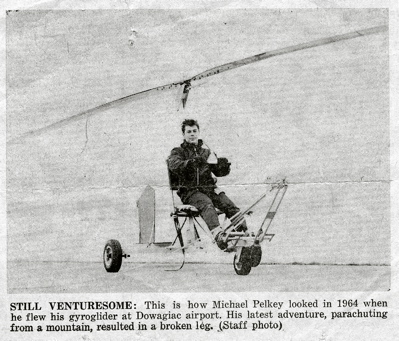
This photo appeared in a Benton Harbor, Michigan newspaper shortly after the
1966 El Capitan jump. Ironically, in the article titled "Jumps Off Mountain", the
reporter states the following: "Mike Pelkey in 1964 thought his new gyrogliding
plane would catch on like go-karting, but his newest venture - parachuting off a
mountain probably won't have much success along similar lines."
In November 1963, Mike was exposed to skydiving for the first time when he watched several jumpers from the Jungle Inn Skydivers club descend into a demo at a Ford dealership across the street from where he worked. As he watched them land he thought, "This is for me" and signed up with the club the next day. On December 31, 1963, Mike went to a New Years party where he bumped into Pinky Johns, the owner of the Jungle Inn Skydivers club, and asked him, "When are you gonna jump me Pinky?". Pinky looked up at Mike and replied, "I'll jump you tommorow".
On January 1, 1964 Mike made his first skydive at the Dowagiac Airport in Michigan. It was a static-line jump from 3,000 feet using a 28-foot LL round canopy and a belly mount reserve. On his 9th jump, Mike had a total malfunction and had to deploy his reserve. The opening shock then caused his main canopy to come out of the container and he landed with 2 rounds out side-by-side.
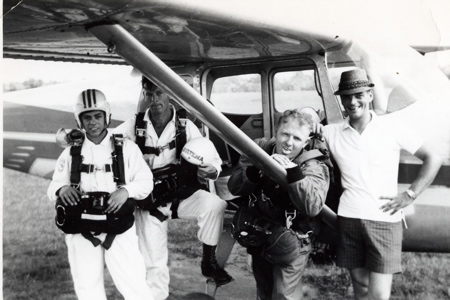
Mike Pelkey, Marv Bultema, Pinky Johns, Eddie Neal at Lawton Airfield, MI
In December 1965, Mike moved to California where he continued to skydive on a regular basis. He met Brian Schubert in March 1966 and they made their first jump together 1 week later at Lake Elsinore, California on March 13, 1966. It was Mike's 167th skydive.
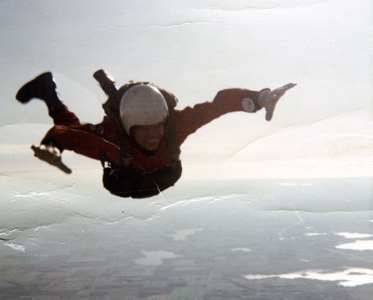
Mike Pelkey skydiving over California 1966
Below is an account of the 1966 El Capitan jump in Mike's own words
The First El Capitan Jump - July 24, 1966
by Mike Pelkey
The year was 1966. I met Brian Schubert in Barstow, California where we both lived. We were both 26 years old and "C" license holders at the time issued by the PCA (Parachute Club of America, since renamed the USPA). On the very first skydive we made together at Lake Elsinore in March of 1966, we were grounded for 30 days for opening below 1,000 feet. The square Ram-air parachute technology hadn't been invented yet, so we had to make do with the round modified military parachutes that were widely used those days. The Cap had never been jumped. There had been a handful of fixed object jumps made earlier in the 1900s from different objects. We were not aware of those jumps at the time.
Our mission was quite simple. We wanted to be the very first parachutists to conquer the Cap. The idea for the jump was neither mine nor Brian's. Another skydiver I worked with at the time mentioned the idea to me. He was not able to make it with us however. When I asked Brian if he would like to do something that had never been done before, he was all for it. We studied every little scrap of information we could find on the El Capitan for the next 30 days or so before we made the trip to Yosemite to make the jump. The El Capitan was my 183rd logged jump on July 24, 1966.
There were three of us on the long, arduous 8 1/2 hour climb to the top. Brian Schubert, Jim Cleary and I started early in the morning of the 24th and didn't make it to the top to jump until about 5:30 in the afternoon. Jim Cleary was not there to jump. He was with us to do his best to record the event with a still camera. The gear was much heavier back then. We did our utmost to appear as backpackers in the event we might be seen by anyone in authority on the way up. We had no idea whether the park rangers would stop us if they happened to recognize that we were parachutists, but we didn't want to take any chances. When we reached the top we came to the most perfect launching pad we could ask for. It was as close to perfectly horizontal as it gets and hung out over the edge at least 6 to 8 feet.
The jump, needless to say was absolutely awesome. We knew we had enough altitude for about ten seconds of freefall (according to legal PCA rules) and stretched that out maybe a couple more seconds. We were both jumping 28-foot TU-7 mains and 24-foot reserves. The fancy parachute, Paracommander, designed especially for sport jumping, had been around for a couple of years but neither of us had one. We both also wore full jump suits, paratrooper boots, and helmets.
As I was finishing getting geared up, Brian beat me to the punch and exited without so much as a warning. I followed right behind him. We knew nothing about still air jumps and we both apparently exited in the same haphazard manner. Two hundred feet below me, to my amazement, Brian began executing a front loop. As I was wondering why he would be performing aerial maneuvers while he was still within ten feet or so of the face, I started my own unintentional front loop, perfectly identical to his. We had no reason to be real concerned about off-heading openings. That was one redeeming characteristic of the good old round parachute. They were made more to float you safely down to earth than to fly you where you might want to go. There was no chance of clearing the trees and making it all the way to the clearing so our only choice was to land on the rocky talus right below the face.
The media was brutal. Contrary to the newspaper reports, we were NOT "repeatedly bashed against the face of the mountain". There certainly was no cliff strike in the freefall part of the jump. I had a bit of trouble after opening trying to maneuver in the erratic winds. At one point I was considerably higher in my open canopy than I was when I opened. I encountered some extreme updrafts and side-drafts. The wind blew in every direction except directly away from the face. At one point, coming out of a tricky side-draft, I made the decision to turn my canopy around to face the mountain so I could see when I hit it and kick myself away. That decision cost me a fractured ankle that I knew I would have to somehow land on in the rocks below.
Brian had worse problems. He encountered winds that actually collapsed his canopy the last 50 feet or so of his descent next to the face. Landing on the rocks below with a collapsing canopy cost him some very severe injuries to both his feet. When I noticed him sprawled out on the rock as I was landing I yelled to him: "Are you all right?" He responded by yelling back: "Get your feet and knees together!" I was fortunate enough to land very softly on another huge rock very close to him, but had already sustained a minor ankle fracture in the cliff strike. Brian broke several metatarsals in both feet.
After I landed, I went over to check on him. He was removing his boots while he still could before his feet began to swell. Rather than to wait until I could go for help, he chose to drag himself all the way to the road on his butt. I stayed behind long enough to field pack our parachutes and began an attempt to carry out all of our equipment. The terrain proved to be too difficult to make any headway on a broken ankle so I soon gave up and left the gear behind. When I finally reached the road, two park rangers and an ambulance crew were there to meet me. Brian had already been transported to the park hospital and had informed them that I was on my way out. One of the rangers accompanied me on the ambulance ride to the hospital. He was very friendly and seemed to delight in hearing about our adventure, as did the hospital staff.
Obviously someone notified the press in the process. I received many calls to the hospital for phone interviews from various news agencies and magazines during my brief stay while they were casting my foot. It was only upon my release that the rangers informed me that they had orders from higher up the command that I was not to leave the park before attending a hearing they had scheduled in three days. Fortunately we had a cabin in Camp Curry and I had both my girlfriend and Brian's girlfriend to use as a pair of crutches while Brian was stuck in the hospital. The rangers went back and found our gear where I left it and informed me that they would hold it until the hearing. They even went so far as to meet our cameraman, Jim Cleary, to confiscate his camera at the foot of the mountain as he was coming down the back trail.
On the day of the hearing they simply informed us that they were unable to find any park regulations prohibiting parachuting from the NPS cliffs. They returned all of our belongings and bid us farewell. Brian's father heard the news about our jump on his car radio as he was on the road to Las Vegas. He was very adamantly opposed to the jump and disallowed our visiting Brian in the hospital after he arrived to pick him up and take him home.
The California State Division of Aeronautics notified us by mail that we were grounded for the rest of our lives and sent a letter to all of the local drop zones instructing them to "notify us and/or the local sheriff's department if either of these jumpers show up at your drop zone requesting to make a parachute jump". Fortunately we knew someone who didn't totally agree with the state's position and was happy to permit us to jump at his DZ as long as we used logbooks with phony names.
Life Magazine decided not to do the story when they saw the quality of the pictures. The editor told me that "Life is essentially a picture magazine" and the pictures were not good enough to print.
Brian and I lost contact less than a year or so after the El Capitan jump. He and I were the best of friends at the time, but he went off to the police academy and I moved away from the area. He was the best man at my wedding to my darling wife of 38 years, Antoinette, and we named our son after him. My son Brian is now 26.
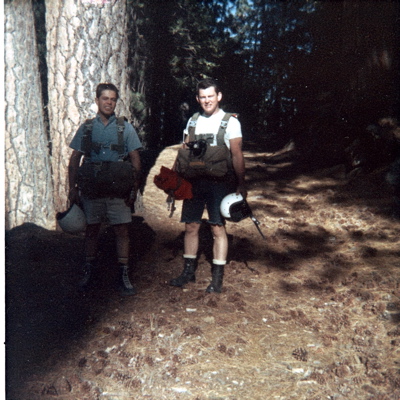
Mike Pelkey and Brian Schubert hike up El Capitan July 24, 1966
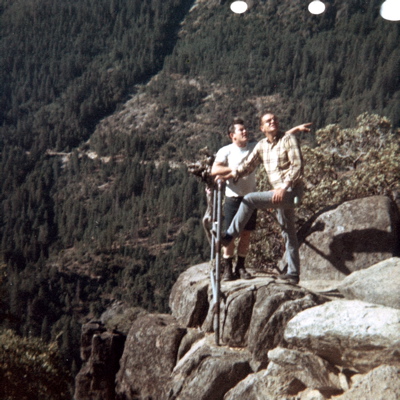
Brian Schubert and cameraman, Jim Cleary, on the way up
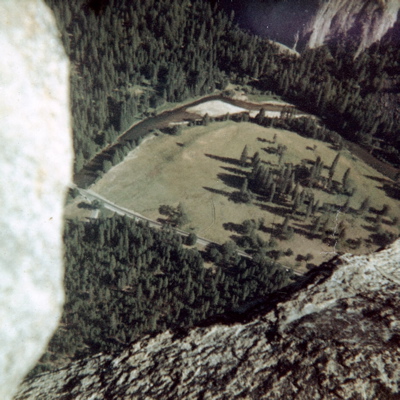
View from the top of El Capitan
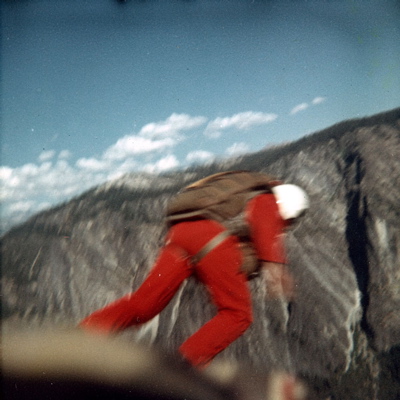
Brian Schubert Exits El Capitan
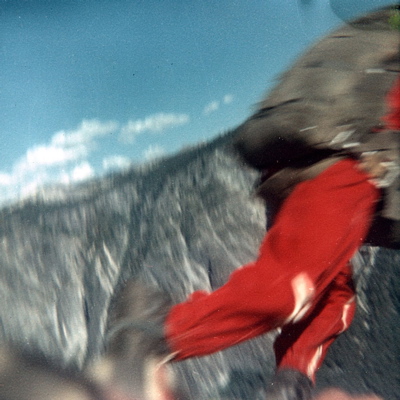
Mike Pelkey Exits El Capitan

Mike Pelkey and Brian Schubert revisit Yosemite with their families 39 years later in August 2005
My Return to BASE Jumping
by Mike Pelkey
Brian Schubert's daughter Tina Googled her father's name and discovered some of the articles on base jumping that mentioned our 1966 El Capitan jump. She took it on herself to locate me. In the process she met Marah Amberlyn Strauch, a young filmmaker doing a movie on base jumping. Marah had already interviewed Brian in Hollywood when I responded to Tina's letter. I met Jean Boenish at Marah's place in Hollywood. Jean presented me with a certificate, which erroneously assigned the position of El Cap 1 to me, signed by Carl before his death. We had never met Carl, and he had no way of knowing which of us was actually first off. All the newspaper accounts referred to us as Mike Pelkey and Brian Schubert, so it was certainly an honest mistake on his part. Brian actually exited two or three seconds ahead of me. Brian and I had a great reunion after more than 37 years. We all made a trip to Yosemite together for a weekend in August and attended the Bridge Day event together in October of 2005. We were invited to speak to the crowd of about 450 base jumpers at the event to talk about our El Cap jump. We were given a very warm welcome by the jumpers, and three standing ovations during our speech.
We met lots of modern-world BASE jumpers, including Johnny Utah, via the internet. Johnny generously offered to let us sit in on his first jump course free of charge, as a "refresher" sort of thing. He must have thought that we would somehow be a little rusty after being away from it for a mere forty years. Brian was recuperating from back surgery at the time, and chose not to attend Johnny's course and was unable make a jump that year. Johnny took a lot of extra effort to be sure I knew enough about the new ram-air technology and proper still-air exiting before I took the plunge on Bridge Day 2005 for my first jump ever with a square. He provided the rig for me and did a 2-way jump with me to capture it on video. Needless to say, the flight under a square canopy was a night-and-day difference from the good old days of jumping modified round military parachutes.
